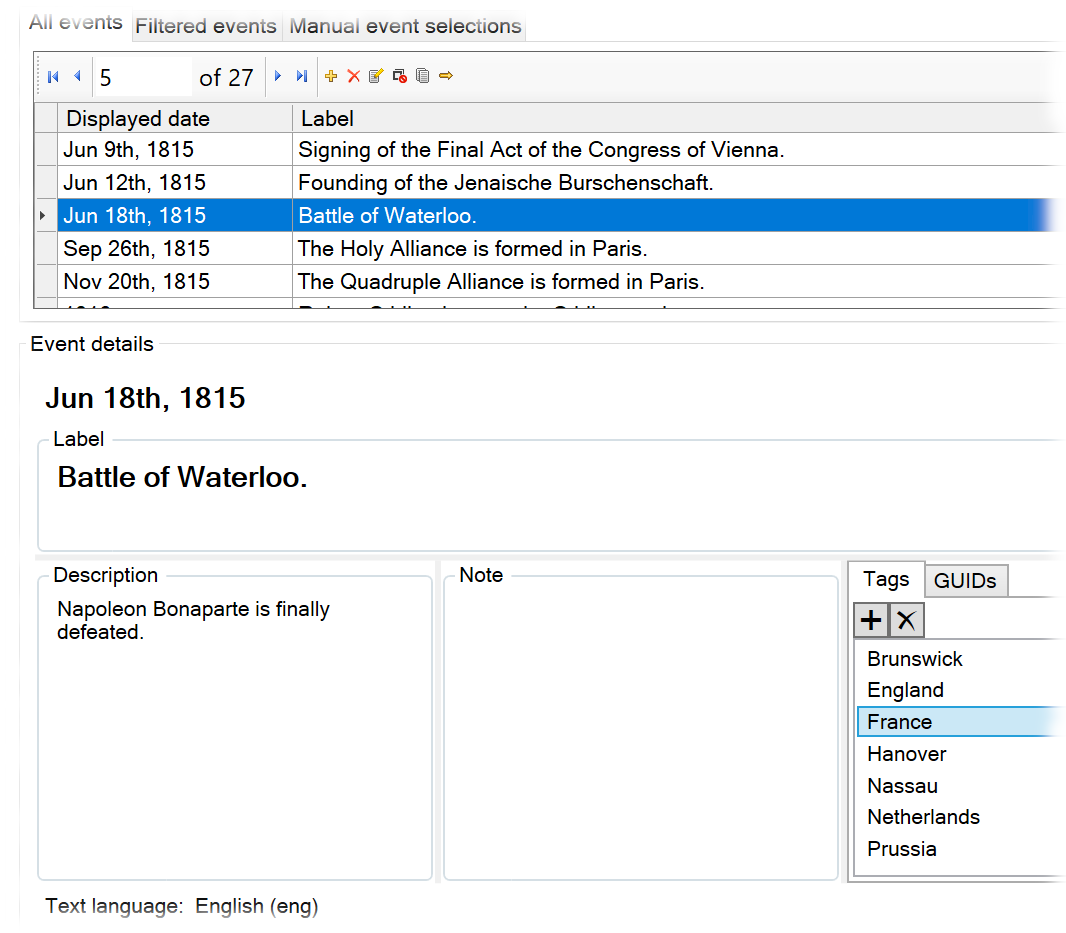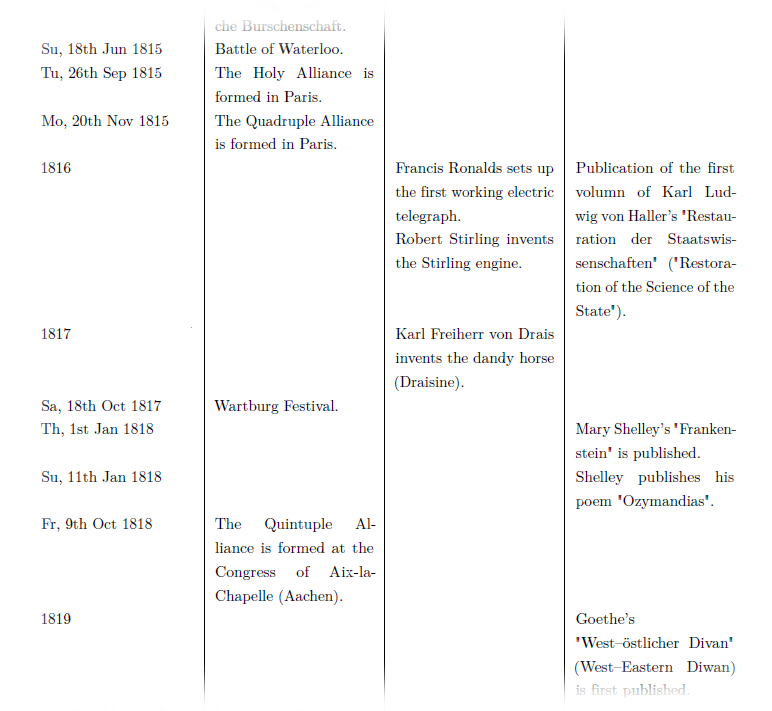Factonaut
developed by Dieter Köhler
published by Anquina
Collect historical events and display them in an orderly fashion.
Factonaut is a computer programme for Windows 10 that allows you to compile historical events in a knowledgebase and easily create chronological overviews. These overviews are formatted as tables, not just as simple timelines. The programme can handle (and convert) dates in both, the Julian and Gregorian calendar systems.
What does Factonaut look like?
Factonaut allows you to store information about individual historical events in a knowledgebase. Here is a (cropped) screenshot of a part of Factonaut's user-interface that shows a list of such event records:

From this data you can generate chronological overviews based on various filter and layout options. Here is a screenshot of a PDF document generated from the above data. Political, technological and literary events are presented in seperate columns:

How does Factonaut work?
The typical process to create a chronological overview consists of the following steps:
- Entering historical data into a knowledgebase and annotating it.
- Creating different selections of the data.
- Defining a structure for an overview.
- Compiling the overview in one of several available file formats.
- Using your favourite text editing tool for post-processing and polishing the overview.
Step 1: Entering historical data
Faconaut's basic data unit is the event record. It is a combination of a date, a label, and optionally a description, a note, multiple tags (keywords) and globally unique identifiers.
Dates can have magnitudes from a second up to 10 billion years. They can represent either a single moment or a period with a start and an end. Factonaut supports two calendar systems: the Gregorian calendar, that is currently used in most of the world, and its predecessor, the Julian calendar.
Event records must have a mandatory label that is later used as the standard output for the chronological overviews. It may be supplemented by an optional (longer) description and an optional note. Output options determine whether these description or notes should be included in the chronological overviews as well.
Event records may be assigned an unlimited number of tags and and globally unique identifiers (GUIDs). Tags are used to categorise events and later to generate selections based on this categories. GUIDs are used to identify duplicates of events in other wordings.
Event records are collected and stored in special files, so-called Factonaut knowledgebases.
Step 2: Creating selections
Within a knowledgebase, selections of event records can be compiled. This can be done completely manually or with the help of a selection wizard, that allows to base a new selection either on all events in the knowledgebase or on an existing selection, or on a union, intersection, difference or symmetric difference of two existing selections. You may then further limit the event recods to be included in the new named selection based on their dates and their associated tags.
Step 3: Defining a structure for an overview
A chronological overview has the form of a table of rows and columns.
The rows are ordered chronological. One column is reserved for dates and the rest of the columns are dedicated to display event data either of all events in the knowledgebase or a specific selection.
So what needs to be done is to define what goes into which column.
In addtion you may specify the way the dates in the date column are formated from various options available. Date formats are currently supported for English and German.
Step 4: Compiling the overview
Factonaut supports the generation of chronological overviews in three different document formats:
- HTML for integrating a chronology into a Web-site or for further processing a chronology with some word processing software, such as Microsoft Word or Libre Office.
- PDF for directly printing a chronology or sending it to someone else. For PDF generation a LaTeX document preparation system that meets certain preconditions needs to be installed first, for example the free MiKTeX distribution.
Step 5: Post-processing and polishing
Factonaut provides only basic formatting options for chronologies. Typically you may want to import a chronological table compiled with Factonaut into your favourite word processing software, HTML or PDF editor in order to refine its layout.
What does Factonaut cost?
There is a basic Herodotus edition of Factonaut with limited capabilities available for evaluation free of charge, a standard Isidor edition for the regular user and a premium Diderot edition with the full feature set.
HerodotusBasic |
IsidorStandard |
DiderotPremium |

|

|

|
|
Free |
49,80 Euro |
99,80 Euro |
| Buy | Buy | |
Supports Gregorian calendar dates. |
Supports Gregorian calendar dates. |
Supports Gregorian calendar dates. |
Supports Julian calendar dates. |
Supports Julian calendar dates. |
Supports Julian calendar dates. |
Supported date/time magnitudes: hour, day, year. |
Supported date/time magnitudes: second, minute, hour, day, year, decade, century, millennium, ... up to 10 billion years. |
Supported date/time magnitudes: second, minute, hour, day, year, decade, century, millennium, ... up to 10 billion years. |
Maximum number of event records in the knowledgebase: 50. |
Unlimited number of event records in the knowledgebase. |
Unlimited number of event records in the knowledgebase. |
No copying of event records from one knowledgebase to another. |
Supports copying of event records from one knowledgebase to another. |
Supports copying of event records from one knowledgebase to another. |
Output footer: "Generated by Factonaut". |
No output footer. |
No output footer. |
Maximum event record columns for HTML output: 2. |
No column limit for HTML output. |
No column limit for HTML output. |
Maximum event record columns for LaTeX output: 2. |
Maximum event record columns for LaTeX output: 2. |
No column limit for LaTeX output. |
Maximum event record columns for PDF output (via LaTeX): 2. |
Maximum event record columns for PDF output (via LaTeX): 2. |
No column limit for PDF output (via LaTeX). |
There is also an upgrade available from the Isidor edition to the Diderot edition for 59,80 Euro.
If you are an individual who really cannot afford buying a license, then send us a postcard from your hometown. Yes, a real postcard by "snail" mail. You find our adress at the bottom of this page. Please explain briefly your situation (student, unemployed, low income country, etc.), tell us your email adress and which edition (Isidor or Diderot) you need. We may send you an individual, single royalty-free license key by email, if we find that you qualify for one. Note that it is solely our decision whether you qualify or not.
System requirements
Factonaut has been developed for Windows 10. It might run on earlier Windows versions or under Windows emulators on other operating systems, but this has not been tested. You may try this out yourself by installing and testing the free Herodotus edition.
For PDF output "LuaLaTeX" must be installed on your system. "LuaLaTeX" is included in major free LaTeX distributions such as MiKTeX and TeX live.
Factonaut's performance on a given system is primarily determined by the size of the connected knowledgebases. When you connect to a knowledgebase, this knowledgebase is completely loaded into the computer's memory. So if you run into performance problems you may limited the number of simultaneously opened knowledgebases or, if this is not sufficient, distribute your data to different knowledgebases (which is, of course, not ideal) or use a computer with more memory.
Downloading and installing Factonaut
All Factonaut editions use the same computer programme. When you download and install it, the feature set of the basic Herodotus edition is automatically enabled. In order to switch to the Isidor or Diderot feature set, you need to purchase a license key. This license key can then be used to activate the corresponding feature set within the Factonaut application.
In case you want to verify the integrity of the Factonaut setup file after downloading it, you may use the following check-sums (this step is optional):
- MD5
0a5f0c9b0243e512ecb9893b72f25121 - SHA256
5f834161136a720d452316ac4d8b2559
c65bde54cc1b2ef29b8eb7be0566a30
In order to install Factonaut, open the folder where the setup programme has been downloaded and double-click on it. At this point Windows usually displays a security warning, asking you whether you really want to open the file. You need to confirm this by clicking on "Open". This launches the installation programme. From here on, just follow the instructions. After the installation is complete, the setup programme is no longer needed. You may archive it, in order to have a backup, or just delete it.
Downloading sample knowledgebases
The following Factonaut knowledgebases are available free of charge to get you started. Download them to your local file system and use the "Connect" command from within Factonaut to work with them.
- Herodotus.fcntkb -- The life of Herodotus of Halicarnassus.
- Isidor.fcntkb -- The life of Isidore of Seville.
- Diderot.fcntkb -- The life of Denis Diderot.